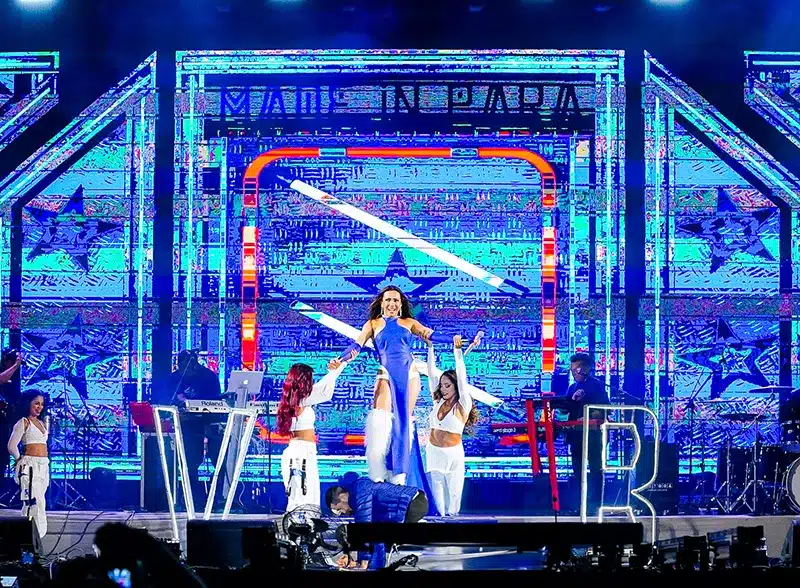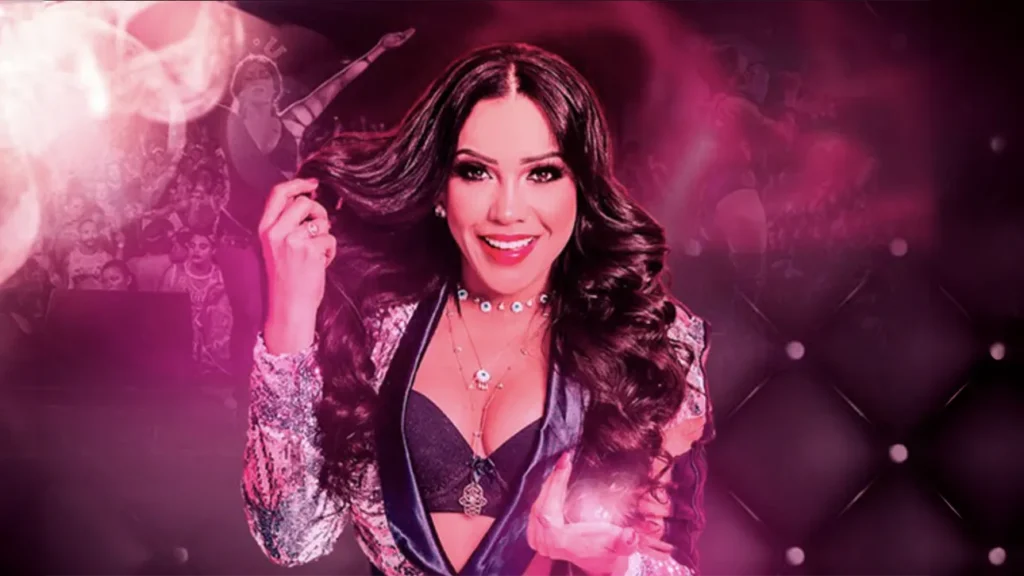
During her appearance at Brazil’s Psica Festival, Viviane Batidão, “The Queen of Tecnomelody”, talks, dances, and sings the sensual joys of Amazonian Pop.
Despite the blistering heat on a Saturday night in December 2024, in the city of Belém, a buzzing crowd packed the grounds in front of the Güera Stage, one of the main attractions at Psica Festival — one of the most important music events in Brazil’s Amazonian region.
Staff members warn fans to keep their distance from the barricades, as fireworks will be used during the show, further intensifying the sweltering atmosphere. Earlier, the same stage had already hosted major acts like BaianaSystem, and the nearby stage was gearing up for artists who sell out arenas in Brazil, such as the rap phenom Duquesa and pop superstar Pabllo Vittar. Still, one of the most feverishly anticipated sets is that of a local diva: Viviane Batidão, crowned in the Brazilian State of Pará as the “Queen of Tecnomelody”.
When Viviane’s show finally kicks off, the staff’s promises are delivered. Fireworks explode at the choreographed high points. It feels like a deeper promise coming true: Amazonian pop is stepping firmly into the national spotlight.

For residents of Pará, catching Viviane live isn’t unusual, but seeing her headline Psica Festival, framed within a parade of national talents, under the trappings of superstardom, feels different. It’s a full display of Pará’s and the Amazon’s vibrant pop scene being recognized for what it truly is: a part of Brazilian pop culture, yet a very unique one. The choreographed dance routines, extravagant costumes, pyrotechnics, and staging that spotlights the showwoman — none of this is new. These elements have long been the lifeblood of brega pop and tecnobrega shows across Pará.
Their roots weave together Brazilian and international influences with an unmistakable regional flair: tributes to Indigenous cultures, ballroom dances, and rhythms born from the rivers and rainforests. The difference now? The rest of Brazil might finally be paying attention.
Brazilian Pop with a Northern Flair
Viviane Batidão has spent nearly two decades building her career. Yet, 2024 marks a turning point — not just for her, but for Amazonian pop as a whole. She clinched the prestigious Prêmio Multishow in the “Brazil” category (which features one artist from each administrative region of the country), while her protégé Zaynara, a Generation Z singer also from Pará, won Best New Artist. The Prêmio Multishow — one of Brazil’s biggest music awards — faced criticism in past years for overlooking artists from the North. Viviane’s acceptance speech cut through that history with stunning clarity:
“The North of Brazil is rich in beauty, full of incredible artists and talents. We consume everything the rest of Brazil produces, but Brazil doesn’t consume our music the way we wish it would.” To PopMatters, Zaynara described her win as a “collective victory”, especially because it was decided by popular vote.
Pop from Brazil’s Northern side seems to be experiencing a second wave. The first wave happened in the early 2000s with Banda Calypso’s meteoric rise to national fame. Nearly 30 years later, although the band is long dissolved, their former frontwoman Joelma’s solo career is thriving. In 2024, her track “Voando pro Pará” (“Flying to Pará”) became a viral sensation across Brazil. With a hook centered around the phrase “eu vou tomar um tacacá” (“I’ll have a tacacá” — a reference to a beloved Amazonian dish), the song turned into a meme, then into a full-blown tourist campaign for the city of Belém.
While Joelma remains a familiar face to Brazilians, a new generation is also seizing the spotlight. Manu Bahtidão, who first gained regional fame as the voice of Banda Batidão, scored a national breakthrough with “Daqui Pra Sempre”, a Portuguese-language version of Loreen’s Eurovision 2023 hit, “Tattoo”.
In contrast to Pará’s long-standing tradition of unauthorized versions of foreign songs, Manu’s polished move signaled a shift for Amazonian pop. The scene had to play by professional rules to grow.
As if a celestial alignment was conspiring in its favor, Amazonian pop got a viral boost in 2024 thanks to social media algorithms. DJ Meury and DJ Ronaldo’s remix “Copo de Veneno” — a remix that meshes the melody from the songbook of an African-based religion, Umbanda, with technobrega beats — exploded on TikTok through a clip of a woman spinning in traditional technobrega style.
Amazonian Pop’s Many Permutations
Amazonian pop comes in many shapes and sounds. It pulls influences from European synthpop, electronic dance music, Latin American ballroom genres, reggae, rock ‘n’ roll, global pop references like Madonna, and of course, Amazonian-born genres like carimbó. The word “brega” is often used as an umbrella term that encompass many of its variants: tecnobrega, tecnomelody, brega saudade, brega calypso, guitarrada, rock doido.
To Viviane Batidão, music made in the Amazon is more than just music. “There’s a rich and powerful culture that encompasses not just the rhythms, but our cultural identity as a whole: our clothes, our food, and the stories of the riverside people,” she tells PopMatters.
Part of the magic of Amazonian pop culture lies in how alien it may feel even to other Brazilians. The dances are unlike any other dance genre made in Brazil. Brega and tecnobrega have their own distinct moves, which are only recently being recognized as part of the Brazilian dance catalog, alongside forró and samba de gafieira.
As for the music, different sounds and artists appeal to the people of the Amazon in ways that don’t exactly resonate with the rest of the country. Nationally acclaimed for songs like “Frevo Mulher”, singer Amelinha was one of the stars of Psica Festival, where she performed “Pressentimento” to a passionate crowd. The song is a classic in Pará’s sound systems, but remains virtually unknown elsewhere.
Another reason why Amazonian pop can feel foreign to Brazilians outside the North is because, in many ways, it is. While Brazil often views itself as culturally isolated from the rest of Latin America, the State of Pará has always maintained a deep connection with the continent’s rhythms, especially cumbia and merengue.
“Unlike most of Brazil, which historically looked to Europe and the U.S. for its musical influences, Pará’s sonic identity has long been rooted in its Latin American neighbors, making its pop music feel both familiar and alien to the rest of the country.”All our references have always been Latin, while the rest of Brazil looked up to Europe”, Viviane Batidão tells PopMatters. “We were isolated. But now, thanks to the new era of the Internet, we’re finally connecting.”
Speaking of the Internet, in many ways, Amazonian pop has always anticipated digital and social media phenomena. Long before TikTok’s sped-up, pitch-shifted songs became a trend, technomelody was already spinning high-BPM instrumentals with high-pitched melodies.
Viviane Batidão Is the Queen of Tecnomelody

Viviane Batidão proudly wears the title of Queen of Tecnomelody — a genre she defines as “electronic music made in the Amazon.” Meanwhile, Zaynara has coined her label: beat melody.
“I took the base of Pará’s brega, elements from brega calypso, guitars, influences from musical icons from my city, like Mestre Cupijó; I mixed it with pop and a custom drum kit,” she tells PopMatters. “Beat melody is a reinterpretation of many Pará rhythms in one place. It’s versatile and lets me experiment. I love the creative freedom [that Amazonian pop allows].”
Weeks before Viviane and Zaynara’s wins at Prêmio Multishow, both singers were featured in Áurea, a special show led by international superstar DJ Alok to celebrate the opening of COP 30 — the United Nations Climate Conference — hosted in Belém. Pará singers Joelma and Gaby Amarantos were also featured.
Electronic music parties are a massive part of Amazonian culture, represented by aparelhagens (sound system parties), where many iconic Northern Brazilian DJs debuted. Now, other Brazilian DJs, such as Pedro Sampaio and Alok, are catching up. During Áurea, Alok’s set highlighted remixes and beats from famed Pará DJs, proudly showcasing tecnobrega and “rock doido” (“crazy rock”), another Amazonian invention.
Rock Doido Electrifies
Despite its name, rock doido shares less with traditional rock ’n’ roll than other variants of brega: it’s the most electronic of the breeds. It even caught the attention of the producers of global electronic music event Boiler Room, who gave DJ Miss Tacacá an entire rock doido-based set.
Rock doido also stole the show during one of Psica Festival’s biggest headliners: Liniker, who ended her concert with an electrifying rock doido remix of her hit “Caju”, produced by DJ Baby Plus Size. “I feel like rock doido is gaining more space and breaking more barriers,” Baby Plus Size tells PopMatters. “It reminds me of how [baile] funk music broke into the mainstream — by bringing something fresh and addictive.”
The comparison to Rio’s baile funk is spot-on. Like technobrega and rock doido, baile funk rose from marginalized communities, fusing electronic beats with raw, local flavor. Despite facing enduring prejudice for its favela origins and often sexually charged lyrics, funk has clawed its way into broader acceptance. It also helped that the genre originated from Rio de Janeiro, a place already positioned in the collective imagination as a Brazilian reference.
Meanwhile, Amazonian pop still faces an uphill battle, emerging from a region even most Brazilians treat as a distant, misunderstood frontier. What’s missing is a cohesive branding effort that ties it to symbols like the Amazon rainforest itself — or perhaps even to its deep, authentic ties to Latin America.
As Belém prepares for COP 30 in 2025, the event is setting a spotlight in the city and Brazil’s North not just culturally (attracting other events such as Amazônia Para Sempre, a Rock in Rio’s spinoff that Mariah Carey will headline), but also politically, raising global awareness of the region and the Amazon rainforest’s critical importance. As Brazil slowly comes to terms with its Latin identity, with the Latin American core rising in social media and even historically overlooked Latin stars like Bad Bunny starting to make waves in the country, perhaps Amazonian pop is on a good course to grow.
“People often say we [Northern Brazilians] are the edge of Brazil,” Viviane Batidão says. “But no — we’re the beginning of Brazil. It’s about time people recognize the power of our music and culture.”


